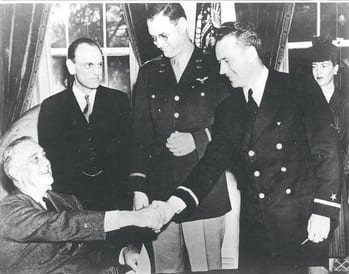
One of Civil Air Patrol’s most famous World War II “subchasers,” honored for heroism by President Franklin Delano Roosevelt, died Dec. 5 after a long illness. He was 96.
Col. Edmond I. “Eddie” Edwards was widely known as the first Coastal Patrol (later Civil Air Patrol) pilot to spot a Nazi U-boat and radio its position to U.S. naval forces. The vessel crash-dived and headed farther out to sea, where it was less of a menace to U.S. shipping. This occurred March 10, 1942, near the start of the war.
“He was probably one of the first subchasers to see the enemy,” said Roger Thiel, a senior member and independent historian with CAP.
Based at Coastal Patrol Base 2 in Rehoboth Beach, Del., Edwards flew sub-hunting patrols offshore Delaware and Maryland, safeguarding oil tankers headed for Delaware Bay. The Coastal Patrol flights, made from 21 bases along the East and Gulf shorelines of America, were instrumental in making CAP an auxiliary of the U.S. Air Force, which it is today.
Thiel said Edwards held “celebrity status” within CAP as one of the first Coastal Patrol pilots awarded the Air Medal for heroism during World War II. He and his commanding officer, the late Maj. Hugh R. Sharp Jr., received the medal after Roosevelt heard of their daring rescue of a fellow airman downed in bitterly cold high seas off Maryland.

Edwards, in an interview for the Civil Air Patrol Volunteer in 2006, clearly remembered the rescue of 1st Lt. Henry Cross that earned him the medal and subchaser fame. “I got the call that one of our planes was down, and Maj. Sharp asked me to go with him,” said Edwards. “We had no trouble finding the crash site. We spotted a body, so we made an emergency landing and fished him out. He was alive, but we never found the other guy.”
The rescue on July 21, 1942, required that Edwards and Sharp land their aircraft, a Sikorsky S-63 single-engine amphibian piloted by Sharp, in swells reaching 8- to 10-feet high and, in the process, they crushed the left pontoon. So, to get back to Base 2, Edwards accomplished a daring feat by climbing out onto the right wing and using his weight to level the plane. A half-frozen Edwards clung there through the night until the early morning hours of the next day before a Coast Guard boat water taxied the unflyable aircraft to shore.
Roosevelt conferred the Air Medal to Edwards and Sharp in a White House ceremony in February 1943. By that time, Edwards had joined the U.S. Navy, where he served as a flight instructor and later piloted Douglas SBD Dauntless dive bombers on patrols out of Hawaii.
“I was ushered into the Oval Office and decorated by FDR,” said Edwards, in the 2006 interview. “Of course, I was honored to receive the medal, but I was also so impressed with FDR.”
Though Edwards and Sharp were the first civilians to receive the Air Medal, they were soon joined by others from their own ranks. By the end of World War II, 800 Air Medals had been presented to CAP members.
Edwards served in the Navy for three years, attaining the rank of senior-grade lieutenant. He served 27 years in the Reserve, during which he pursued an active role in Delaware civil aviation. For a number of years, he ran the FBO and instructed at Weimer Airport at Newark, Del., now site of a DuPont facility.
Thiel, a longtime acquaintance of Edwards who frequently visited with him during annual Coastal Patrol Base 2 reunions in Rehoboth Beach, said he often downplayed his notoriety. “Eddie never considered himself special for the high profile personal recognition by President Roosevelt, often saying of the rescue for which his Air Medal was awarded, ‘Anyone could have done it,’ ” said Thiel. “His accomplishments and humility indicate the heroic capabilities of regular U.S. citizens, especially in Civil Air Patrol.”
Edwards is survived by his wife, Blanche, and a son and two daughters: Edmond Jr., who lives in Missouri; Linda Jones of Shillington, Pa.; and Patricia Dawson of Bear, Del.
For more information: GoCivilAirPatrol.com
